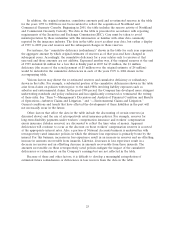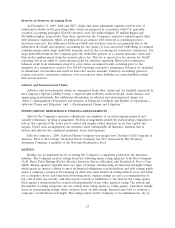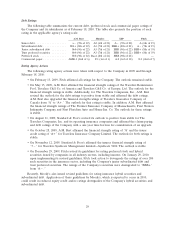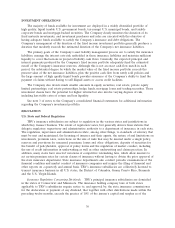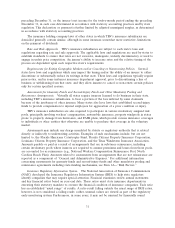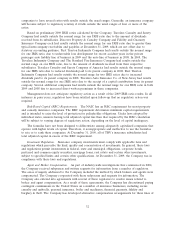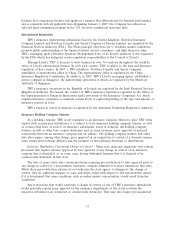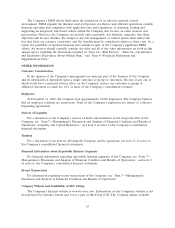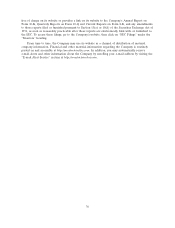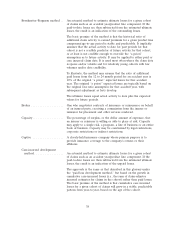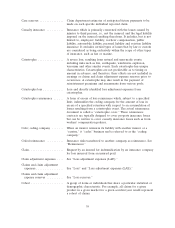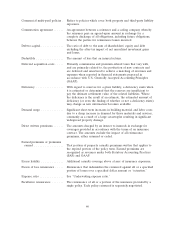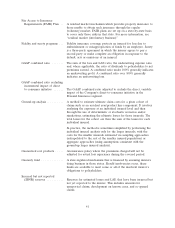Travelers 2009 Annual Report Download - page 46
Download and view the complete annual report
Please find page 46 of the 2009 Travelers annual report below. You can navigate through the pages in the report by either clicking on the pages listed below, or by using the keyword search tool below to find specific information within the annual report.notification in those states that have adopted pre-acquisition notification provisions and in which such
insurance subsidiaries are admitted to transact business.
Two of TRV’s insurance subsidiaries and its operations at Lloyd’s are domiciled in the United
Kingdom. Insurers in the United Kingdom are subject to change of control restrictions in the Financial
Services and Markets Act of 2000 including approval of the Financial Services Authority. Some of
TRV’s other insurance subsidiaries are domiciled in, or authorized to conduct insurance business in,
Canada. Authorized insurers in Canada are subject to change of control restrictions in Section 407 of
the Insurance Companies Act, including approval of the Office of the Superintendent of Financial
Institutions.
These requirements may deter, delay or prevent transactions affecting the control of or the
ownership of common stock, including transactions that could be advantageous to TRV’s shareholders.
ENTERPRISE RISK MANAGEMENT
As a large property and casualty insurance enterprise, the Company is exposed to many risks.
These risks are a function of the environments within which the Company operates. Since certain risks
can be correlated with other risks, an event or a series of events can impact multiple areas of the
Company simultaneously and have a material effect on the Company’s results of operations, financial
position or liquidity. These exposures require an entity-wide view of risk and an understanding of the
potential impact on all aspects of the Company. It also requires the Company to manage its risk-taking
to be within its risk appetite in a prudent and balanced effort to create and preserve value for all of
the Company’s stakeholders. This approach to Company-wide risk evaluation and management is
commonly called Enterprise Risk Management (ERM). ERM activities involve both the identification
and assessment of a broad range of risks and the execution of synchronized strategies to effectively
manage such risks.
ERM at the Company is an integral part of business operations. All risk owners across all
functions, all corporate leaders and the Board of Directors are engaged in ERM. ERM involves
risk-based analytics, as well as reporting and feedback throughout the enterprise in support of the
Company’s long-term financial strategies and objectives.
The Company uses various analyses and methods, including sophisticated computer modeling
techniques, to analyze catastrophic events and the risks associated with them. These analyses and
methods are used in making underwriting and reinsurance decisions and are designed to aid in the
management of the Company’s exposure to catastrophic events. In addition to catastrophe modeling
and analysis, the Company also models and analyzes its exposure to other extreme events. Terrorism
provides a unique type of exposure, as discussed further in ‘‘Item 1A—Risk Factors.’’ These activities
are an integral component of the Company’s ERM process and further support the Company’s
long-term financial strategy and objectives.
In addition to the day-to-day ERM activities within the Company’s business units, other key
internal risk management functions include the Management Committee (comprised of the Company’s
Chief Executive Officer and the other most senior members of management), the Risk Committee of
management, the Credit Committee, the Chief Compliance Officer, the Business Conduct Officer, the
Corporate Actuarial group, the Corporate Audit group, the Accounting Policy group, the Enterprise
Underwriting group and many others. A senior executive oversees the ERM process at a corporate
level. The mission of this executive is to facilitate risk assessment and to collaborate in implementing
effective risk management strategies throughout the Company. Another strategic ERM objective of this
executive includes working across the Company to enhance effective and realistic risk modeling
capabilities as part of the Company’s overall effort to understand and manage its portfolio of risks to
be within its risk appetite. Board oversight of ERM is provided by the Risk Committee, which reviews
the strategies, processes and controls pertaining to the Company’s insurance operations and oversees
the implementation, execution and performance of the Company’s enterprise risk management
program.
34



